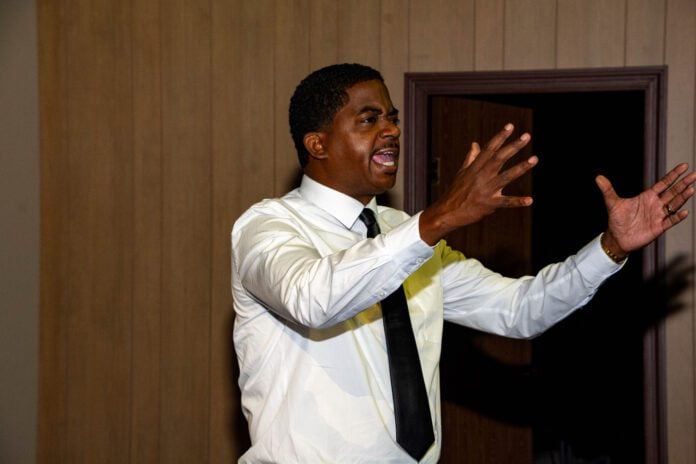
Indianapolis Black Theatre Company’s production of “The Mountaintop” is onstage for its last few performances this weekend. Here’s everything you should know in case you’ve still haven’t seen it.
Directed by IBTC’s Creative Director Tijideen Rowley, “The Mountaintop” is a compelling theatrical historical fiction about Dr. Martin Luther King Jr.’s last night on Earth. Written by Katori Hall, “The Mountaintop” is an imagined scenario between Dr. Martin Luther King Jr. and a motel maid named Carrie Mae, or “Camae,” in room 306 of the Lorraine Motel on the night of April 3, 1968.
The show debuted in London in 2009 and eventually premiered on Broadway in 2011 starring Samuel L. Jackson and Angela Bassett. “The Mountaintop” is complex and raw — and still incredibly timely based on the incredible 14 year run in various playhouses across the country.
Starring Daniel A. Martin as Dr. King and Dija Renuka as Camae, The IBTC debuted the show at the District Theatre on Sept. 18, and the room was packed. People laughed, gasped, cried and left the theatre after a standing ovation.
READ MORE: REVIEW: IRT’s season opener ‘The 39 Steps’ is delightfully absurd
Clarissa Michelle stepped into the role of Camae every performance since, as Renuka sustained an injury backstage on opening night, according to a press release.
Regardless of who played the role, Camae is more than what meets the eye. She is lovely, bubbly and charming but also passionate, eccentric and outspoken. An admirer of “Preacher King,” Camae’s compassion is forged from pain and grief, though she is outwardly distraught by her own lack of decorum, bad habits and “potty mouth” on display in front of Dr. King.
Pacing around a stuffy motel room in dress slacks and socks all while rain beats down against the window, Martin’s Dr. King was dynamic; sorrowful and angry, charismatic and coy, unguarded, and dare I say it, silly.
Another thing of note is that the lighting and sound design are essential to the audiences’ immersion into the story. The District Theatre is an intimate space, where very little space separates the actor from the viewer. A fourth wall exists, of course, but at times you feel like a fly on the Lorraine Motel wall — as uncomfortable or as enjoyable as that may be. Very little shakes you out of the dream set loose within those motel walls than the sharp crack of thunder and quick flash of lightning — or the theater version of such.
It’s loud. The torrential downpour and blustering snowstorm sow unease throughout the show. The sounds of the storm aren’t just a metaphor or a symbol, they’re a reminder— a warning, of the impending doom that awaits Dr. King the next morning. It’s meant to be reminiscent of a gunshot, and the way Martin clutches at his chest in fear is enough to incite anxiety and grief within the characters onstage and in the audience.
The play does not shy away from alluding to Dr. King’s assassination — both in passing dialogue and in a more literal sense. It’s unsettling and grim, uncomfortable even, but it sets the scene for more difficult conversations to be had while Dr. King and Camae continue to smoke and joke and laugh throughout this perceived limbo.
Then there is the dark humor, quick-wit and desire for what could have been. Much like the theatrical references to his death, “The Mountaintop” does not shy away from morbid and sensual topics and jokes.
The set and costume design are also immaculate. I am always impressed with what IBTC is able to do with small casts and intimate spaces, such as the District Theatre Mainstage, but blown away doesn’t even cover it. There is simplicity in the familiar. I think the warm glow of a hotel lamp, raggedy motel room towels and well-worn carpet and drapes add to the storytelling as much as a suitcoat and stinky dress shoes or an apron and press and curls does.
A show is good when it relies on more than just the words on a page. Between Camae’s flower petal tears and Dr. King’s tense argument with God (she/her), “The Mountaintop” came alive in the hands of the IBTC.
The impending doom is almost enough to distract you from the tension building between Dr. King and Camae as conversation flows between Civil Rights marches, fighting for fair wages for waste management workers, and intimate details of Dr. King’s life outside of his activism and ministry.
The show humanizes the legendary leader, the visionary and martyr we celebrate with a day off from work every January 15th-ish. “The Mountaintop” includes words from his “I’ve Seen the Mountaintop” speech, while shedding equal light on the things that made him vulnerable. He was not fearless, nor without fault or flirtatious tendencies for women other than his wife. “The Mountaintop” portrays him as the man he was — and then some. He smoked, drank, cussed, had holes in his socks and wondered whether his words would ever make a difference.
“The Mountaintop” isn’t at all what I expected, which makes it all the more intriguing. IBTC made Hoosiers a promise as a newer creative space to focus on telling Black stories that “challenge, inspire and unite audiences,” Rowley said in a press release earlier this year. “The Mountaintop,” and its unique but provocative portrayal of Dr. King, does all three of these things.
The ending will leave you with hope, and a little more.
“The Mountaintop” is onstage at The District Theatre Sept. 25-28. The show is roughly an hour and a half. Tickets start at $20 . For more information, visit indydistricttheatre.org.
Chloe McGowan is the Arts & Culture Reporter for the Indianapolis Recorder Newspaper. Originally from Columbus, OH, Chloe has a bachelor's in journalism from The Ohio State University. She is a former IndyStar Pulliam Fellow, and has previously worked for Indy Maven, The Lantern, and CityScene Media Group. In her free time, Chloe enjoys live theatre, reading, baking and keeping her plants alive.




